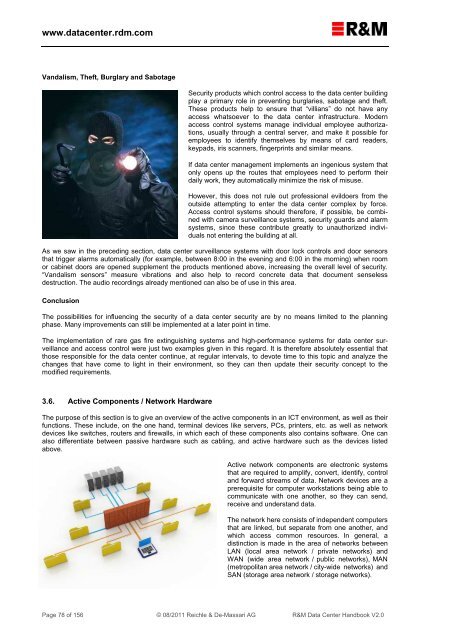R&M Data Center Handbook
R&M Data Center Handbook
R&M Data Center Handbook
Create successful ePaper yourself
Turn your PDF publications into a flip-book with our unique Google optimized e-Paper software.
www.datacenter.rdm.com<br />
Vandalism, Theft, Burglary and Sabotage<br />
Security products which control access to the data center building<br />
play a primary role in preventing burglaries, sabotage and theft.<br />
These products help to ensure that “villians” do not have any<br />
access whatsoever to the data center infrastructure. Modern<br />
access control systems manage individual employee authorizations,<br />
usually through a central server, and make it possible for<br />
employees to identify themselves by means of card readers,<br />
keypads, iris scanners, fingerprints and similar means.<br />
If data center management implements an ingenious system that<br />
only opens up the routes that employees need to perform their<br />
daily work, they automatically minimize the risk of misuse.<br />
However, this does not rule out professional evildoers from the<br />
outside attempting to enter the data center complex by force.<br />
Access control systems should therefore, if possible, be combined<br />
with camera surveillance systems, security guards and alarm<br />
systems, since these contribute greatly to unauthorized individuals<br />
not entering the building at all.<br />
As we saw in the preceding section, data center surveillance systems with door lock controls and door sensors<br />
that trigger alarms automatically (for example, between 8:00 in the evening and 6:00 in the morning) when room<br />
or cabinet doors are opened supplement the products mentioned above, increasing the overall level of security.<br />
“Vandalism sensors” measure vibrations and also help to record concrete data that document senseless<br />
destruction. The audio recordings already mentioned can also be of use in this area.<br />
Conclusion<br />
The possibilities for influencing the security of a data center security are by no means limited to the planning<br />
phase. Many improvements can still be implemented at a later point in time.<br />
The implementation of rare gas fire extinguishing systems and high-performance systems for data center surveillance<br />
and access control were just two examples given in this regard. It is therefore absolutely essential that<br />
those responsible for the data center continue, at regular intervals, to devote time to this topic and analyze the<br />
changes that have come to light in their environment, so they can then update their security concept to the<br />
modified requirements.<br />
3.6. Active Components / Network Hardware<br />
The purpose of this section is to give an overview of the active components in an ICT environment, as well as their<br />
functions. These include, on the one hand, terminal devices like servers, PCs, printers, etc. as well as network<br />
devices like switches, routers and firewalls, in which each of these components also contains software. One can<br />
also differentiate between passive hardware such as cabling, and active hardware such as the devices listed<br />
above.<br />
Active network components are electronic systems<br />
that are required to amplify, convert, identify, control<br />
and forward streams of data. Network devices are a<br />
prerequisite for computer workstations being able to<br />
communicate with one another, so they can send,<br />
receive and understand data.<br />
The network here consists of independent computers<br />
that are linked, but separate from one another, and<br />
which access common resources. In general, a<br />
distinction is made in the area of networks between<br />
LAN (local area network / private networks) and<br />
WAN (wide area network / public networks), MAN<br />
(metropolitan area network / city-wide networks) and<br />
SAN (storage area network / storage networks).<br />
Page 78 of 156 © 08/2011 Reichle & De-Massari AG R&M <strong>Data</strong> <strong>Center</strong> <strong>Handbook</strong> V2.0


